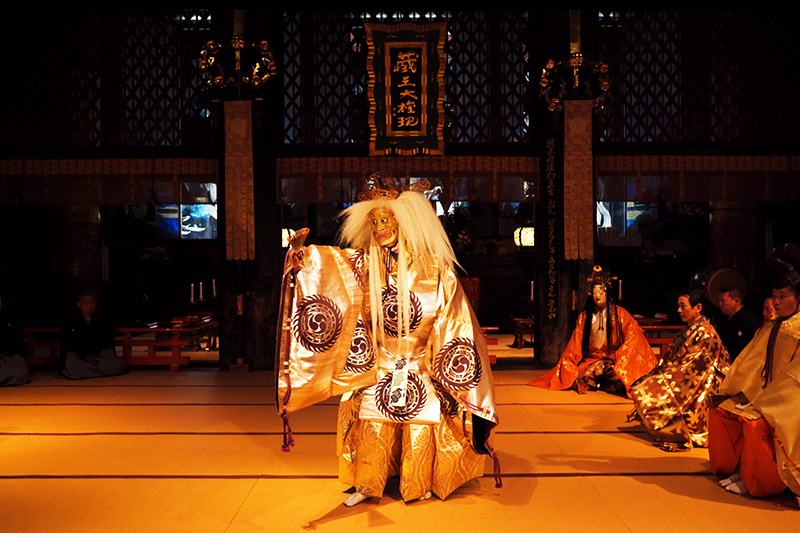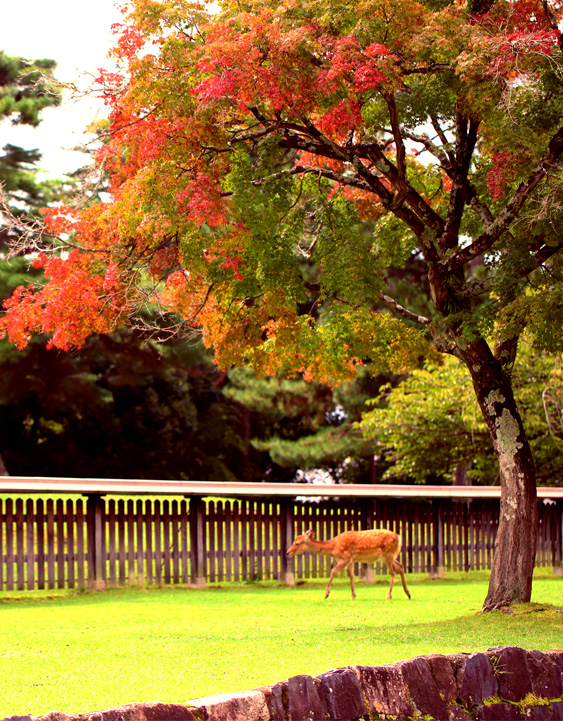A Sacred Place Where Sarugaku, the Predecessor of Noh, was Performed in Olden Times
Kinpusenji Temple
.jpg)
World Heritage Sites Main Hall and Niomon Gate
Kinpusenji Temple is known as a famous cherry blossom viewing spot and the symbol of Mt. Yoshino, and is the head temple of Shugendo.
Mt. Yoshino has been considered a sacred place since ancient times, and when Shugendo was established in the Kamakura period (1185-1333), the temples and shrines spread all over the mountain joined together and were collectively called Kinpusenji.
Walking from the Mt. Yoshino station on the ropeway, you will see the main gate of Kinpusenji Temple, the Kuromon Gate, followed by the Niomon Gate on the uphill approach lined with inns, restaurants, and souvenir stores, and the main hall on the hill beyond.
In 2004, the Main Hall and Niomon Gate were registered as a World Heritage Site as part of the "Sacred Sites and Pilgrimage Routes in the Kii Mountain Range.
.jpg)
Twice a year, in spring and autumn, there is a special exhibition of Japan's largest hidden Buddha.
The Main Hall (photo) has a front span of five rooms, a side span of six rooms, and a height of about 34 meters, making it the second largest ancient wooden structure after Todaiji Temple's Great Buddha Hall.
The prinicipal image of the 3 forms of Zao Gongen are known as Japan's largest hidden wooden statues at about 7 meters tall, and are open to viewing by the public for a limited time twice a year, in spring and autumn.
This year (2021), the image will be shown from October 22 (Fri.) to November 30 (Tues.). During this period, there will be a "nighttime viewing" limited to overnight guests of Mt. Yoshino called "Shomyo and the Secret Buddha Zao Gongen Floating in the Dark," where you can enjoy a fantastic nighttime viewing experience with only candlelight illuminating the hall where the Shomyo chanting resonates.
.jpg)
A Shrine Where Sarugaku was Performed in the Muromachi Period
Kinpusenji and Noh have a longstanding relationship, and it is written in the "Annual Events of the Temple" that Sarugaku, the predecessor of Noh, was performed at the Nogikai held at Tenma Shrine (currently Daitoku Tenmangu Shrine, see photo), which was located in the temple precincts of the Main Hall during the Muromachi period.
A variety of Noh performances are still held at the Main Hall, from professional Noh performers to amateur dedication performances.
Infomation
- Address
2498 Yoshinoyama Yoshino-cho,
Yoshino-gun, Nara-ken 639-3115
Japan- Tel
+81-746-32-8371
- Traffic Guide
10 minutes walk from Yoshinoyama Station on the Yoshinoyama Ropeway
- Website
Enjoy Nohgaku through Music

Noh "Kuzu"
The setting
Yoshino
Story
When Emperor Tenmu escapes to the mountains of Yoshino and rests in solitude, an old couple living in the house he resides in return by riverboat.
A performance full of highlights created against the backdrop of the greatest civil war in ancient times,The Jinshin War.
Special Video
Photo Gallery
This is a collection of photos of the landscapes of Nara & Yoshino, bursting with seasonal charms, and famous sites related to Nohgaku. We will also introduce some off-screen shots from the filming of "Kuzu" at Kinpusenji Temple main hall.
The Charms of the Seasons in Yoshino, Nara
.jpg)
Mt. Yoshino, where about 30,000 cherry trees bloom
Since ancient times, cherry trees have been planted on Mt. Yoshino by the believers of Shugendo, who regarded cherry trees as sacred trees, and today there are about 30,000 cherry trees densely planted on the mountain, mainly shiroyama cherry trees.
The cherry blossoms that cover the mountain as far as the eye can see are described as "a thousand at a glance" (meaning that you can see a thousand cherry trees at a glance).
The blossoms are at their peak in early April. The blossom season starts in the foothills of the mountain in an area called Shimosenbon and continues for nearly a month, moving up the mountain to Nakasenbon, Kamisenbon and Okusenbon. Each area has its own well-known trees and groups of trees, making it possible to enjoy the diversity of the cherry blossoms.
At night the cherry trees in full bloom are lit up, creating an ethereal atmosphere among the blossoms.
.jpg)
A Relaxing Walk Amidst the Elegant Hydrangeas
Visit the Nanamagari Hydrangea Garden where the flowers add a variety of colors to the dazzling deep green of early summer.
The Nanamagari slope is located at the entrance to Mt. Yoshino, and along the slope that twists and turns parallel to the ropeway, about 4,000 hydrangea plants are planted, filling the area with pastel-colored flowers in the rainy season.
The Nanamagari slope is closed to general traffic, so you can enjoy a leisurely stroll while admiring the hydrangeas.
The Hydrangea Festival is held every year from early June to early July. At this time there will be a stamp rally and other events.
.jpg)
Famous Cherry Blossoms Sites Also Offer Beautiful Autumn Leaves
On Mt. Yoshino, the leaves of the cherry trees begin to turn vermilion in mid-October, and in November the maple trees are almost at their peak, with red, yellow, and orange covering the entire mountain. This makes for an incredible sight. In a reverse from the cherry blossoms, you can watch the colors change from the top of the mountain to the bottom.
The Hanayagura Observatory in Kamisenbon is the best place to see a panoramic view of the mountain bedecked with autumn leaves.
In addition, Saigyo-an (photo: Tatehiko Yano), located quietly in Okusenbon at the very top of the mountain, is a famous spot for viewing hidden autumn leaves. In the place where Saigyo, a poet active from the Heian to Kamakura periods, is said to have retreated for a while, you can enjoy the brilliantly colored autumn leaves.
.jpg)
Enjoy Mt. Yoshino in the Snow while Visiting Historical Temples
Mt. Yoshino becomes a silvery white world in winter. The mountains are enveloped in a quiet and solemn atmosphere, and you can enjoy a different mood from that of spring and autumn.
Before the Heian period (794-1185), Mt. Yoshino was known as the "snowy mountain of Yoshino," and there are many famous poems written about the snowy landscapes.
When the famous sites and ruins of Mt. Yoshino are enveloped in a white, wintery quiet, we recommend visiting historical temples while enjoying the snowy setting.
Every year in February, the Setsubun Festival is held at Kinpusenji Temple's Main Hall, and at the "Oni Festival on Mt. Yoshino" held in conjunction with the Setsubun Festival, you can see the oni (ogres) parading through the town.





















.jpg?width=320&name=IMG_5347-(1).jpg)
.jpg?width=320&name=IMG_5361-(1).jpg)

.jpg?width=320&name=IMG_5405-(1).jpg)
.jpg?width=320&name=IMG_5410-(1).jpg)




